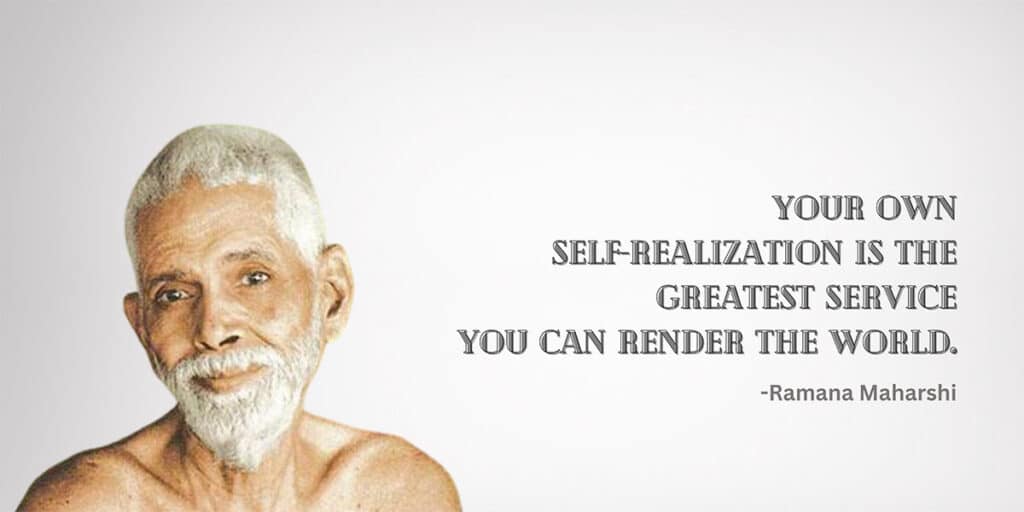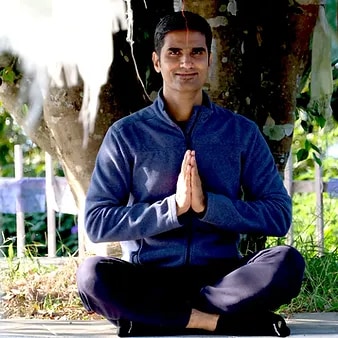The Teachings of Sri Ramana Maharshi
by Hardik Mehta

The Teachings of Sri Ramana Maharshi
Yoga, an ancient spiritual discipline originating in India, has gained widespread popularity in the modern world as a holistic practice for physical, mental, and spiritual well-being. Among the luminaries of yoga philosophy stands Ramana Maharshi, whose profound insights and teachings continue to inspire seekers on the path of self-realization. While Ramana Maharshi is not traditionally associated with the physical postures (asanas) commonly practiced in yoga studios, his life and teachings embody the essence of yoga in its deepest sense.
Ramana Maharshi’s spiritual journey began with a spontaneous and profound experience of self-realization at the age of sixteen. This awakening, which occurred in his hometown of Tiruchuli, marked the beginning of a lifelong exploration of the nature of the self and the ultimate reality. Unlike some yogis who underwent rigorous physical disciplines to attain enlightenment, Ramana Maharshi’s approach was characterized by self-inquiry and surrender rather than elaborate yogic practices.
Nevertheless, Ramana Maharshi’s teachings resonate deeply with the principles of yoga, albeit in a more subtle and internalized form. At the core of yoga philosophy lies the concept of union (yoga), which encompasses the harmonization of body, mind, and spirit. Ramana Maharshi’s emphasis on self-inquiry and self-realization can be seen as a profound form of inner union, where the individual self merges with the universal consciousness.
One of the key teachings of Ramana Maharshi is the practice of self-inquiry, known as “Atma-Vichara” in Sanskrit. This process involves probing deeply into the nature of the self by asking the fundamental question, “Who am I?” Through relentless self-examination, one gradually unravels the layers of conditioning and false identities that veil the true self. This process of introspection and self-discovery aligns with the yoga tradition’s emphasis on self-awareness and self-transformation.
Ramana Maharshi’s teachings also emphasize the importance of stillness and inner peace, qualities that are central to the practice of yoga. He often encouraged seekers to abide in the “heart-centre,” the core of their being where the mind dissolves into pure awareness. In this state of silent contemplation, the restless mind finds rest, and the practitioner experiences a profound sense of tranquillity and unity with the divine.
While Ramana Maharshi did not prescribe specific yogic techniques or postures, he recognized the value of disciplined practice in purifying the mind and preparing it for self-realization. In his view, any sincere spiritual practice that helps quiet the mind and turn inward can be considered a form of yoga. Whether it is meditation, breath control (pranayama), or devotional chanting (bhakti), the goal remains the same: to transcend the limitations of the ego-mind and realize one’s essential nature.
Ramana Maharshi’s own life exemplified the transformative power of yoga in its truest sense. Despite facing numerous challenges and hardships, including the diagnosis of a terminal illness at a young age, he remained anchored in the unshakable peace of his true nature. His presence radiated a profound tranquillity that touched all who came into contact with him, offering solace and guidance in their own spiritual journeys.
In the broader context of yoga philosophy, Ramana Maharshi’s teachings align with the path of Jnana Yoga, the yoga of knowledge and wisdom. This path emphasizes the direct realization of the self through discernment and insight, rather than through ritualistic practices or external forms of worship. By cultivating a clear understanding of the nature of reality and the self, practitioners of Jnana Yoga come to recognize their inherent divinity and transcend the cycle of birth and death.
In conclusion, while Ramana Maharshi may not be traditionally associated with the physical practices of yoga, his life and teachings embody the essence of yoga in its deepest sense. Through the practice of self-inquiry, stillness, and inner peace, seekers can experience the transformative power of yoga and realize their true nature as pure consciousness. In the words of Ramana Maharshi himself, “Your own self-realization is the greatest service you can render to the world.” May we heed his timeless teachings and embark on the path of yoga, leading us to the ultimate realization of the self
Embark on a transformative journey with Sayujya Yoga’s esteemed 200-Hour Teacher Training Course, renowned as one of India’s premier yoga institutes. Immerse yourself in the rich tapestry of yogic philosophy and principles, drawing wisdom from the revered yogis and maharishis whose legacy has shaped the essence of yoga. Our comprehensive curriculum offers a holistic approach, encompassing asanas, meditation, pranayama, and more. Under the guidance of experienced instructors, delve deep into the ancient teachings while honing your teaching skills. Join us at Sayujya Yoga and unlock the path to self-discovery, spiritual growth, and becoming a certified yoga teacher.
About the Author

Hardik Mehta
Hardik is an E-RYT 500 & YACEP (Yoga Alliance Continuing Education Provider), Yoga Alliance, USA. He has been practicing yoga for the last 9 years. Prior to finding his true calling in Yoga, he was working with various corporates for 12 years in the Retail and eCommerce sector.
